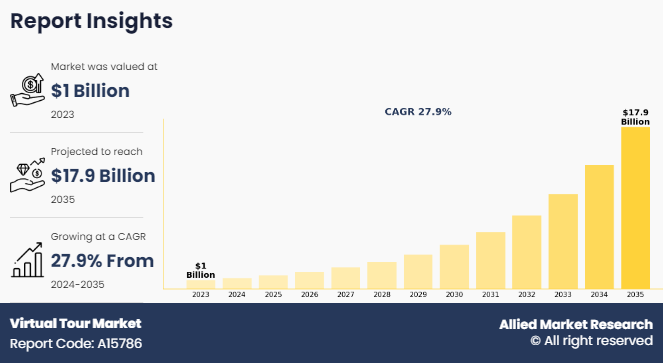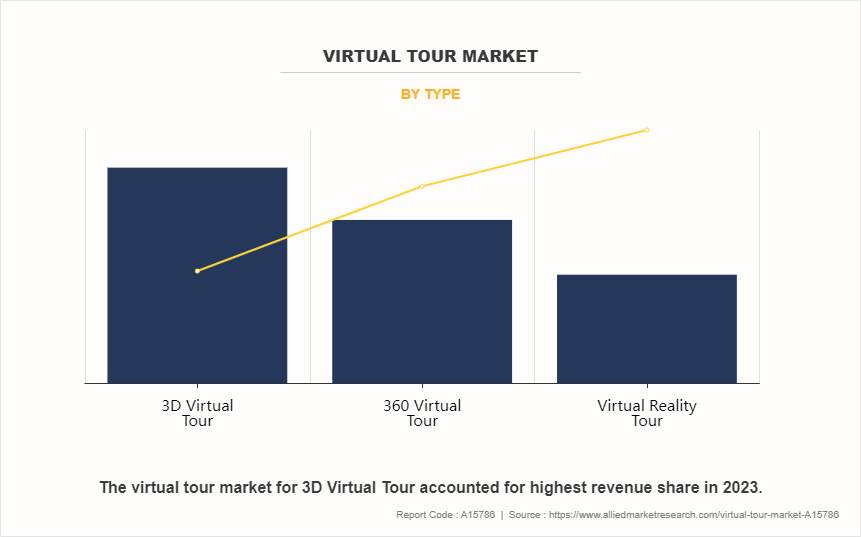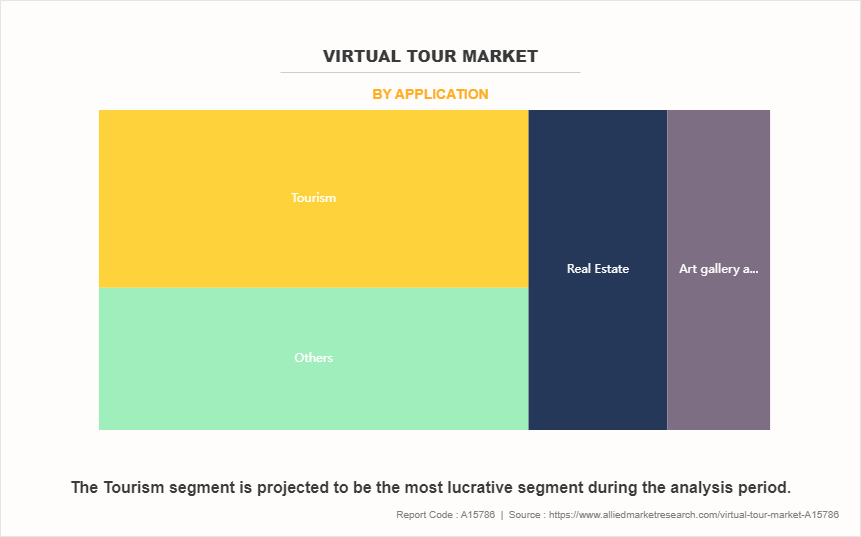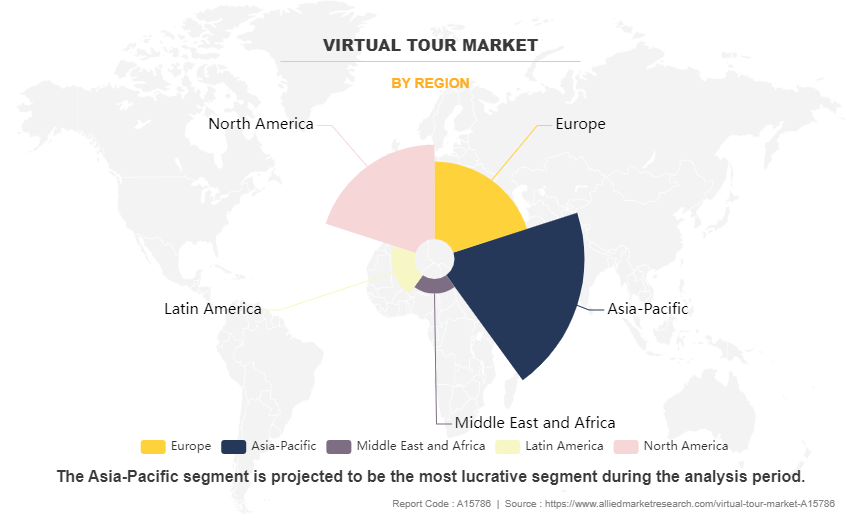Virtual Tour Market Research, 2035
The global virtual tour market was valued at $0.96 billion in 2023, and is projected to reach $17.88 billion by 2035, registering a CAGR of 27.9% from 2024 to 2035. The virtual tour market is primarily driven by advancements in virtual reality and augmented reality technologies, along with a rise in demand for immersive experiences and the growth of the travel and tourism industry. Moreover, the impact of the COVID-19 pandemic on remote experiences, as well as rise in e-commerce and real estate industries, has further driven the market growth.

A virtual tour is a digital simulation of a physical location, typically consisting of a series of images or videos that are arranged together to create a seamless, immersive experience. By utilizing technologies such as virtual reality (VR) or augmented reality (AR), virtual tours allow users to explore and interact with the simulated environment from a remote location. Users can easily navigate through different areas and view panoramic scenes. Virtual tours are commonly used in various industries, including real estate, tourism, education, and entertainment, offering a convenient and engaging way to showcase properties, destinations, or experiences.
Key Takeaways
- By type, the 3D virtual tour segment was the highest revenue contributor to the market in 2023.
- By application, the tourism segment was the largest segment in the global virtual tour market during the forecast period.
- Region-wise, Asia-Pacific was the highest revenue contributor in 2023.
Market Dynamics
New regulations regarding work in various IT/BPO firms are expected to boost the flexibility for the companies to adopt work-from-home and work-from-anywhere policies. The virtual tour market demand increased as many firms adopted work-from-home policies owing to the lockdown measures implemented during the COVID-19 pandemic to prevent community spread of the disease.
Thus, the trend of stay-at-home measures post COVID-19 pandemic resulted in opportunities for virtual tour companies to integrate new technologies and develop products and services with distinguishing features to gain a competitive edge over others. In addition, corporates and commercial real estates are extensively using virtual tours for exploring and meetings. For instance, Microsoft claimed that Microsoft Team surpassed 44 million daily active users in March 2020 as organizations increasingly used online platforms to continue their business process during lockdown. Also, Microsoft has claimed to have 320 million monthly active users in the first quarter of 2024. Thus, such factors, along with rise in awareness toward virtual events, propel the growth of the virtual tour market share.
In addition, the expansion of the travel and tourism industry has boosted the demand for virtual tours to offer immersive experiences to individuals interested in exploring various destinations. Virtual tours provide an opportunity for travelers to preview attractions, accommodations, and activities remotely, allowing them to make more informed decisions about their trips. This pre-travel exploration builds anticipation and helps travelers plan and customize their itineraries based on their interests and preferences. Moreover, virtual tours cater to the evolving desires of modern travelers who seek authentic and personalized experiences. Tourists can virtually visit iconic landmarks, museums, and cultural sites worldwide, deepening their understanding of different destinations and cultures.
Moreover, virtual tours address concerns related to accessibility and sustainability in travel by providing inclusive experiences to individuals with mobility issues and reducing the environmental impact associated with physical travel. As the travel industry rebounds from disruptions such as the COVID-19 pandemic, the demand for virtual tours is anticipated to persist, offering a convenient and complementary way for travelers to explore the world on their terms.
Furthermore, advertisements and promotions remain a vital business practice, pre-COVID, during COVID, or post-COVID, to increase awareness about products and services offered by various companies. Before the pandemic, individuals preferred to attend events physically; however, post COVID-19 outbreak, individuals were strictly restricted to stay home. Thus, virtual events and tours gained momentum during the pandemic. Similar to how individuals were restricted to attain virtual events, sponsors were left with no choice other than to organize virtual tours. Thus, sponsorship has provided material support to events or organizations, leading to the growth of virtual tour market in recent years.
Sponsorship enables virtual tour market players to virtually advertise their products and reach a large consumer base; thereby fueling the adoption of their products. Moreover, it helps to focus on consumer preference and to foster brand loyalty. Furthermore, it draws attention from existing and potential customers of a brand or company and creates a positive impact on them, thereby leading to increase in brand loyalty. Sponsors further check the past proven records of a particular event and the probability of success before they sponsor an event, as they invest in a plan and expect a positive return on the investment. The most common sponsorship is in sports, real estate, and entertainment, ranging from local to regional and international virtual tours. Thus, surge in sponsorships for virtual tours and events significantly contributes toward the growth of the virtual tour industry.
Even though the market has expanded, there are certain challenges that hinder the virtual tour market growth. Limited access to virtual reality (VR) and augmented reality (AR) equipment presents a significant restraint on the market demand for virtual tours. While VR headsets and AR devices offer immersive experiences, their adoption is hindered by their relatively high cost and limited availability. Many consumers, especially those in developing regions or with lower incomes, may lack the financial means to purchase VR/AR equipment, leading to a reduced market potential for virtual tour providers. This lack of accessibility limits the reach and impact of virtual tours, reducing their effectiveness as a marketing and sales tool.
Moreover, the complexity of VR/AR equipment and the need for technical expertise to operate them further worsen the accessibility issue for users. Even for users who can afford VR headsets or AR devices, the learning curve associated with setting up and using the equipment may act as a challenging factor and is anticipated to hamper the market growth during the virtual tour market forecast period.
There are numerous market opportunities for the virtual tour market. Virtual tours of healthcare facilities have created significant opportunities by providing innovative solutions for patient education and facility tours. These virtual tours offer patients and their families the opportunity to explore healthcare facilities remotely, gaining familiarity with the layout, amenities, and services available. By experiencing virtual tours before physical visits, patients can alleviate anxiety and better prepare for their appointments or procedures, ultimately improving their overall healthcare experience.
Furthermore, virtual tours of healthcare facilities enhance transparency and trust between healthcare providers and patients. Patients can access virtual tours from the comfort of their homes, allowing them to make more informed decisions about their healthcare options. In addition, virtual tours can serve as valuable marketing tools for healthcare facilities, attracting new patients and setting themselves apart from competitors. By leveraging virtual tours for patient education and facility tours, healthcare providers can improve patient satisfaction, increase engagement, and ultimately drive growth in the virtual tour market in the healthcare sector.
Thus, as technology continues to evolve, the development of more accessible and user-friendly tools for virtual tour creation and consumption is anticipated, lowering barriers to entry and expanding market reach. Furthermore, the integration of artificial intelligence and machine learning algorithms into virtual tour platforms holds promise for enhancing personalization and interactivity, thus enriching the user experience and driving engagement. In addition, the rising demand for virtual experiences in the wake of global events such as the COVID-19 pandemic highlights the market's resilience and potential for sustained growth. As businesses and consumers alike embrace the convenience and flexibility offered by virtual tours, the market is poised for continued expansion, with new opportunities emerging in various sectors and applications.
Segmental Overview
The virtual tours market is segmented into type, application, and region. On the basis of type, the market is categorized into 360 virtual tour, 3D virtual tour, and virtual reality tour. By application, it is segregated into tourism, real estate, art gallery & museums, and others. Region-wise, it is analyzed across North America (the U.S., Canada, and Mexico), Europe (the UK, Germany, France, Italy, Spain, Russia, and rest of Europe), Asia-Pacific (China, Japan, India, Australia, South Korea, Indonesia, Malaysia, and rest of Asia-Pacific), Latin America (Brazil, Argentina, Colombia, and rest of Latin America), and Middle East and Africa (GCC, South Africa, and rest of Middle East and Africa).
By Type
By type, the 3D virtual tour segment dominated the global virtual tour market in 2023 and is anticipated to continue the same trend during the forecast period. 3D virtual tours can be created with beautiful details and a multitude of interactive options. They can be deployed on the web or packaged into apps for mobile, desktop, and other platforms. The emergence of the internet has led to intense exposure of people to social media sites. People first browse through websites, gather detailed information, and review the required product or service before making a purchase. In addition, social media such as Facebook, Twitter, and travel blogs have become a common medium for people to discuss travel plans. Consumers are experiencing the 3D virtual tour for various applications such as tourism, real estate, museums, among others.

By Application
By application, the tourism segment led the global virtual tour market in 2023 and is anticipated to maintain its dominance during the forecast period. In virtual tourism experiences, immersive VR aims to create an environment where users can fully engage their five senses, facilitating natural interactions within the virtual space. It employs a variety of output and input devices that adhere to principles of motion, ensuring a seamless and immersive virtual experience. In addition, this segment prioritizes the user's experience within the virtual simulation. Virtual tourism makes destinations accessible to millions of people across the world, who may otherwise not be able to afford to travel to them. Viewers are embracing the rise in virtual tourism destinations and the increasing quality and availability of virtual reality technology to see and experience things they never thought possible. Moreover, virtual tourism has seen a huge growth in the last few years owing to the arrival of COVID-19 pandemic.

By Region
Region-wise, Asia-Pacific is anticipated to be the major shareholder during the forecast period. With an expanding population and rapidly expanding internet access, countries like China, India, and Southeast Asian nations offer a vast and diverse user base for virtual tour platforms. The widespread connectivity serves as a driver for the adoption of virtual tours across various sectors, including real estate, tourism, hospitality, and education. In addition, the region's emerging economies are experiencing rapid urbanization and industrialization, driving demand for innovative solutions such as virtual tours to showcase properties, attractions, and educational institutions to a broader audience.
Furthermore, Asia-Pacific's tech-savvy culture and thriving technology ecosystems in countries such as China, South Korea, and Japan play a pivotal role in driving the virtual tour market size. Technological expertise facilitates the development of cutting-edge virtual tour solutions, pushing the boundaries of immersive experiences and driving market growth. Moreover, the rich cultural heritage and vibrant tourism industry in Asia-Pacific attract millions of visitors annually, providing ample opportunities for virtual tours to explore historical sites, museums, and landmarks. Thus, the cultural significance further cements the region's position as a key player in the global virtual tour industry.

Competitive Analysis
The key players in the virtual tour market include Pan 3Sixty, MI 360, 360 Pano VR Solutions Private Limited, 360 Imagery, Exsight 360, Blue Raven Studios, Invision Studio, Inc, Starts360, TourVista, and Eye Revolution Ltd.
Key Benefits For Stakeholders
- This report provides a quantitative analysis of the market segments, current trends, estimations, and dynamics of the virtual tour market analysis from 2023 to 2035 to identify the prevailing virtual tour market opportunities.
- The market research is offered along with information related to key drivers, restraints, and opportunities.
- Porter's five forces analysis highlights the potency of buyers and suppliers to enable stakeholders make profit-oriented business decisions and strengthen their supplier-buyer network.
- In-depth analysis of the virtual tour market segmentation assists to determine the prevailing market opportunities.
- Major countries in each region are mapped according to their revenue contribution to the global market.
- Market player positioning facilitates benchmarking and provides a clear understanding of the present position of the market players.
- The report includes the analysis of the regional as well as global virtual tour market trends, key players, market segments, application areas, and market growth strategies.
Virtual Tour Market Report Highlights
| Aspects | Details |
| Market Size By 2035 | USD 17.9 billion |
| Growth Rate | CAGR of 27.9% |
| Forecast period | 2023 - 2035 |
| Report Pages | 258 |
| By Type |
|
| By Application |
|
| By Region |
|
| Key Market Players | 360 Imagery, Starts360, Invision Studio, Inc, Blue Raven Studios, Eye Revolution Ltd, 360 Pano VR Solutions Private Limited, Pan 3Sixty, Exsight 360, MI 360, TourVista |
Analyst Review
As per the perspective of top-level CXOs, the global virtual tours market is expected to offer various business opportunities in the coming years. CXOs view virtual tours as more than just a temporary solution during times of crisis like the COVID-19 pandemic; rather, they see them as a fundamental aspect of future business strategies. Virtual tours are expected to offer unparalleled opportunities for innovation, customer engagement, and cost-effectiveness.
According to the CXOs, rapid development of the events in sports, gaming, and entertainment sectors over the past decade and increase in use of technology such as Internet of Things (IOT), artificial intelligence, and augmented & virtual reality to streamline the events from start to end are the prime factors that drive the market growth. Furthermore, many real estate and manufacturing industries are investing in virtual tour software to increase security of their information and data shared online and reduce compliances issues in the organization. Adoption of advanced technologies such as artificial intelligence (AI), virtual reality (VR), and augmented reality (AR) is further expected to create lucrative opportunities for the industry players in the coming years.
In addition, top leaders emphasize the importance of staying ahead of technological trends and investing in cutting-edge virtual tour solutions to maintain a competitive edge in the market. Overall, they are optimistic about the sustained growth of the virtual tour market and its transformative impact on the way businesses operate and interact with customers in the digital age.
The global virtual tour market was valued at $0.96 billion in 2023, and is projected to reach $17.88 billion by 2035, registering a CAGR of 27.9% from 2024 to 2035.
The base year calculated in the Virtual Tour market report is 2023.
The forecast period in the Virtual Tour market report is 2024 to 2035.
The 3D virtual tour segment is the most influential segment in the Virtual Tour market report.
The top companies analyzed for the global Virtual Tour market report are Pan 3Sixty, MI 360, 360 Pano VR Solutions Private Limited, 360 Imagery, Exsight 360, Blue Raven Studios, Invision Studio, Inc, Starts360, TourVista, and Eye Revolution Ltd.
The company profile has been selected on the basis of revenue, product offerings, and market penetration.
The market value of the Virtual Tour market in 2023 was $0.96 billion.
Asia-Pacific holds the maximum market share of the Virtual Tour market.
Loading Table Of Content...
Loading Research Methodology...


